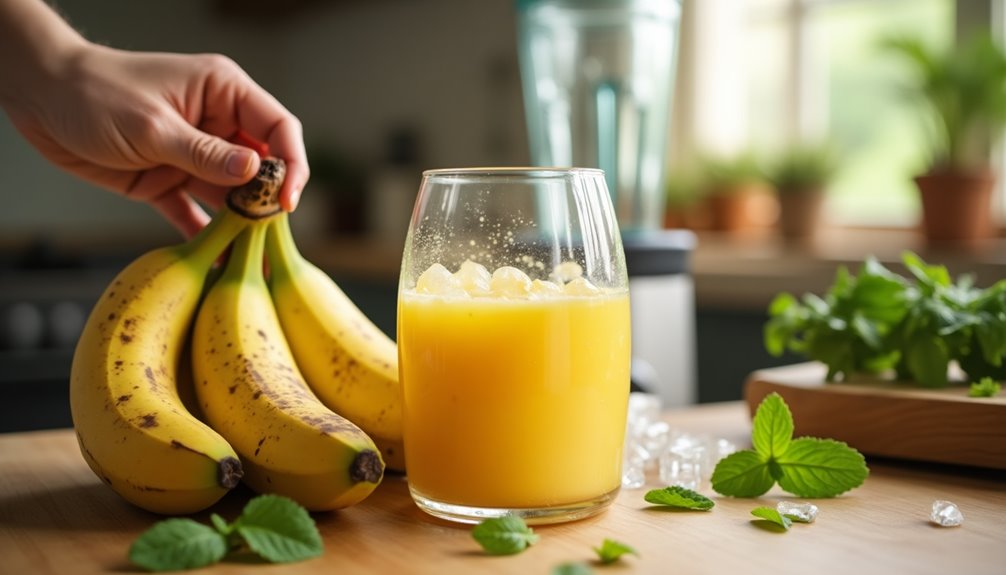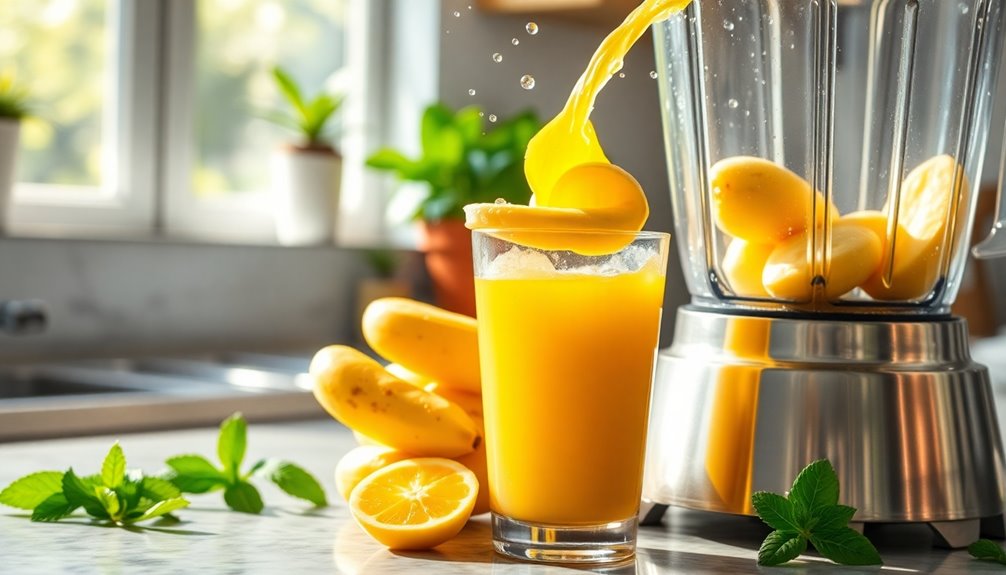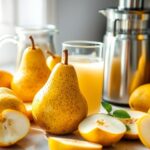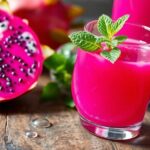To make banana juice, peel and slice two ripe bananas, then blend them with 1½ cups of chilled milk or water until smooth. You can add half an apple for extra fiber and vitamins if you’d like. Adjust the consistency by adding more liquid for a thinner juice or keeping it as is for a thicker texture. Sweeten with honey if desired. Enjoy it immediately for the best taste, but keep going to discover more tips and variations! For a refreshing twist, consider blending in a handful of spinach or kale to boost the nutritional value without altering the flavor too much. You can also experiment with different fruits, such as mango or pineapple, to create unique blends. If you’re looking to expand your juicing repertoire, learning how to juice a grapefruit can add a zesty kick to your morning routine—just remember to adjust the sweetness depending on your preference!
Key Takeaways
- Peel and slice 2 ripe bananas, then place them in a blender.
- Add 1½ cups of chilled milk or water to the blender.
- Optionally, include half a medium apple for added flavor and nutrients.
- Blend on high until smooth, adjusting liquid for desired consistency.
- Serve immediately or store in an airtight container for up to 24 hours.

Making banana juice is a simple and delicious way to enjoy this nutritious fruit. If you've got ripe bananas on hand, you're already halfway to creating a refreshing drink. To start, peel and slice two large ripe bananas. The riper they are, the sweeter and more flavorful your banana juice will be.
Next, grab your blender—this is key, as a blender will help you achieve that smooth puree you're aiming for. Avoid using a juicer, since the low water content in bananas can clog it up, making blending the way to go.
Once you've added the sliced bananas to your blender, pour in about 1½ cups of chilled milk or water. If you prefer a creamier texture, chilled milk will give you that rich flavor. On the other hand, if you're looking to keep things lighter, water is a great option.
Blend the mixture on high until it's smooth and creamy. You can adjust the thickness of your banana juice by adding more liquid if you like it thinner or keeping it as is for a thicker consistency. Either way, you'll end up with a delicious banana juice recipe that's totally worth the effort.
For an extra layer of flavor and nutrition, consider including half a medium apple, cut into pieces. This addition not only enhances the taste but also adds some fiber and vitamins to your drink. If you find the mixture isn't sweet enough for your taste, don't hesitate to sweeten it with a splash of honey or your favorite sweetener. This step is completely optional, but it can help maximize the deliciousness of your banana juice.
Once everything is blended together, it's best to consume your banana juice immediately. The oxidation process can cause the juice to brown, which can affect its taste and appearance. Enjoying it fresh ensures you get all the vibrant flavors and nutrients packed into this drink.
If you happen to have leftovers, you can refrigerate them in an airtight container for up to 24 hours or even freeze them for later use. Just keep in mind that the flavor is at its peak when it's freshly made.
Now that you know how to make banana juice, you can whip up this delightful drink whenever you want. Whether it's a quick breakfast, a post-workout refreshment, or a tasty treat, banana juice is a versatile option.
Frequently Asked Questions
How Do You Extract the Juice From a Banana?
To extract juice from a banana, you can start by pureeing ripe bananas in a blender. Their high water content helps separate the liquid from the solids.
If you've got frozen bananas, microwaving them briefly in a covered bowl can enhance the extraction.
Straining the blended mixture through a fine mesh strainer gives you a clearer juice.
Alternatively, you might try traditional methods like mixing with grass for a naturally extracted flavor.
How to Make Banana Liquid?
To make banana liquid, start by peeling and slicing ripe bananas for their natural sweetness.
Blend the slices with your choice of liquid, like milk or water, until smooth. If you want extra flavor, toss in other fruits or sweeteners like honey.
For a clearer liquid, strain the mixture through a fine mesh strainer.
Serve it right away to enjoy the best taste and nutritional benefits—don't let it sit too long!
Is It Possible to Juice a Banana?
Yes, you can juice a banana, although it's a bit tricky since bananas have low water content.
Traditional juicing methods won't work well, but if you blend the banana and strain it, you'll get a flavorful juice.
You could also freeze the bananas to break down the cell walls, making extraction easier.
Don't be surprised—banana juice does exist and can pack a strong banana flavor when done right!
Is Banana Juice Healthy?
Imagine sipping on a creamy, golden banana juice, bursting with natural sweetness and vibrant flavor.
You'll find that banana juice is indeed healthy! It's packed with potassium, supporting your heart, while the natural sugars provide a quick energy boost.
Plus, it's low in fat and free from added sugars, making it a great choice for anyone, including kids.
Enjoying it in moderation can also help with digestion thanks to its dietary fiber content.
Conclusion
Now that you've crafted your delicious banana juice, you've not only created a refreshing drink but also a moment of joy in your day. Each sip is a reminder that even the simplest pleasures can brighten our lives. So, go ahead and savor this little treasure, turning a humble fruit into a delightful experience. Remember, it's not just juice; it's a sweet escape that invites happiness into your routine. Cheers to the small joys that make life a little brighter!
Cindy thoroughly researches juicing trends, techniques, and recipes to provide readers with practical advice and inspiration. Her writing style is accessible, engaging, and designed to make complex concepts easy to understand. Cindy’s dedication to promoting the advantages of juicing shines through her work, empowering readers to make positive changes in their lives through the simple act of juicing.

















